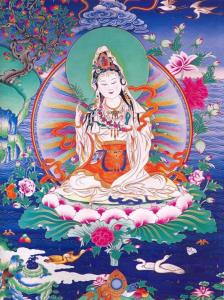 Post from my friend Ganga Nath on Facebook.
Post from my friend Ganga Nath on Facebook.
Tara, or Ārya Tārā, also known as Jetsun Dolma in Tibetan Buddhism, is a female Bodhisattva in Mahayana Buddhism who appears as a female Buddha in Vajrayana Buddhism. She is known as the “mother of liberation”, and represents the virtues of success in work and achievements.
In Japan she is known as Tara Bosatsu, and little-known as Duōluó Púsà in Chinese Buddhism.
Tara is a tantric meditation deity whose practice is used by practitioners of the Tibetan branch of Vajrayana Buddhism to develop certain inner qualities and understand outer, inner and secret teachings about compassion and emptiness. Tara is actually the generic name for a set of Buddhas or bodhisattvas of similar aspect. These may more properly be understood as different aspects of the same quality, as bodhisattvas are often considered metaphors for Buddhist virtues.
The most widely known forms of Tārā are:
- Green Tārā, (Syamatara) known as the Buddha of enlightened activity
- White Tārā, (Sitatara) also known for compassion, long life, healing and serenity; also known as The Wish-fulfilling Wheel, or Cintachakra
- Red Tārā, (Kurukulla) of fierce aspect associated with magnetizing all good things
- Black Tārā, associated with power
- Yellow Tārā, (Bhrikuti) associated with wealth and prosperity
- Blue Tārā, associated with transmutation of anger
There is also recognition in some schools of Buddhism of twenty-one Tārās. A practice text entitled In Praise of the 21 Tārās, is recited during the morning in all four sects of Tibetan Buddhism.
The main Tārā mantra is the same for Buddhists and Hindus alike: oṃ tāre tuttāre ture svāhā. It is pronounced by Tibetans and Buddhists who follow the Tibetan traditions as oṃ tāre tu tāre ture soha.
Emergence of Tārā as a Buddhist deity
Tārā became a very popular Vajrayana deity with the rise of Tantra in 8th-century Pala and, with the movement of Indian Buddhism into Tibet through Padmasambhava, the worship and practices of Tārā became incorporated into Tibetan Buddhism as well. She eventually came to be considered the “Mother of all Buddhas,” which usually refers to the enlightened wisdom of the Buddhas, while simultaneously echoing the ancient concept of the Mother Goddess in India.
Independent of whether she is classified as a deity, a Buddha, or a bodhisattva, Tārā remains very popular in Tibet (and Tibetan communities in exile in Northern India), Mongolia, Nepal, Bhutan, and is worshiped in a majority of Buddhist communities throughout the world (see also Guanyin, the female aspect of Avalokitesvara in Chinese Buddhism).
Today, Green Tara and White Tara are probably the most popular representations of Tara. Green Tara (Khadiravani) is usually associated with protection from fear and the following eight obscurations: lions (pride), wild elephants (delusion/ignorance), fires (hatred and anger), snakes (jealousy), bandits and thieves (wrong views, including fanatical views), bondage (avarice and miserliness), floods (desire and attachment), and evil spirits and demons (deluded doubts). As one of the three deities of long life, White Tara (Sarasvati) is associated with longevity. White Tara counteracts illness and thereby helps to bring about a long life. She embodies the motivation that is compassion and is said to be as white and radiant as the moon.
Tārā as a focus for tantric deity yoga can be traced back to the time period of Padmasambhava. There is a Red Tārā practice which was given by Padmasambhava to Yeshe Tsogyal. He asked that she hide it as a treasure. It was not until the 20th century, that a great Nyingma lama, Apong Terton rediscovered it. This lama was reborn as His Holiness Sakya Trizin, present head of the Sakyapa sect. A monk who had known Apong Terton succeeded in retransmitting it to H.H. Sakya Trizin, and the same monk also gave it to Chagdud Tulku Rinpoche, who released it to his western students.
As Chagdud Tulku Rinpoche, in his Introduction to the Red Tārā Sadhana, notes of his lineage:
“Tārā is the flawless expression of the inseparability of emptiness, awareness and compassion. Just as you use a mirror to see your face, Tārā meditation is a means of seeing the true face of your mind, devoid of any trace of delusion.”
Be First to Comment